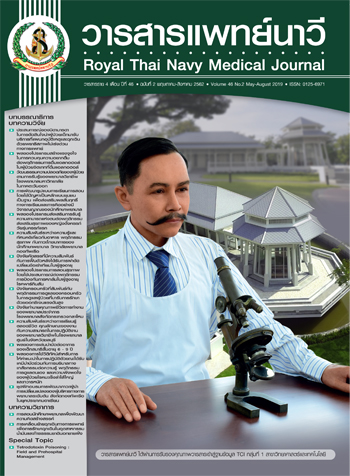Parental Experiences in Decision Making in Bringing Children with non-Urgent Medical Conditions to the Emergency Department
Main Article Content
Abstract
This qualitative research used Husserl phenomenology approach. The purpose was to describe the parental experience in decision making in bringing children with non-urgent medical conditions to the emergency department. The informants were mothers who brought their children with non-urgent medical conditions to the emergency department. Data were collected by using the in-depth interview with tape-record and found saturated after 15 informants. Data were transcribed verbatim and analyzed by using Colaizzi method.
The findings revealed that parental experiences in deciding to bring children with non-urgent medical conditions to the emergency department can be categorized into 4 major themes as follows: 1) anxiety, fear of their children’s symptom will getting worse with their care, when the care is not improved, feeling fear of getting worse, some parents are worried because their children having underlying medical conditions and from past experience their children have had serious illnesses; 2) confidence, trust in their treatment, parents thinking getting services at the emergency department will receiving elaborate physical examination, having fully-equipped medical devices ready to save lives, not getting cured from others therefore want to receive services from the emergency department; 3) being convenient, no emergency department crowding, the service at the emergency department there are few places and procedures for getting treatment, less wait-time, convenient time for travel and having someone to bring them to the hospital, and 4) low cost and no redundant expense. Service at the emergency department is not expensive and if bringing children to clinic if condition not improve, it must be re-examined at the hospital. But come to the emergency department if there have serious illnesses they can admit in the hospital not pay for the treatment again.
The findings reflect the experiences of parents who make decisions in bringing their children to the emergency department. Nurses can use this information in planning better office hour service by using an approach that and applying lean and seamless service delivery. Including creating a teaching model for primary pediatric nursing giving priority to parents, families, to be able to caring their children with non-urgent medical conditions at home. Improving skills in assessing and appropriately. Consider to nursing that is suitable for children and build confidence in the services provided during office hours.
Article Details

This work is licensed under a Creative Commons Attribution-NonCommercial-NoDerivatives 4.0 International License.
References
2. Queen Sirikit National Institute of Child Health, Emergency department statistics on patient classification accident and emergency, fiscal year 2011-2014. (in Thai).
3. Wong AC, Claudet I, Mullet E. Why do parents bring their children to the emergency department a systematic inventory of motives? International Journal of Family Medicine; 2015.
4. Kubicek K, Beaudin C, Supan J, Weiss G, Lu Y, Kipke MD. A profile of non-urgent emergency department usage in an urban pediatric hospital. Pediatric Emergency Care 2012;28(10):977-84.
5. Queen Sirikit National Institute of Child Health. Patient screening criteria Queen Sirikit National Institute of Child Health 4 levels; (Grey Literature). (in Thai).
6. Veen MV. The Manchester Triage System in pediatrics emergency care. Erasmus Universiteit Rotterdam, The Netherlands. [Internet]. [cited 2015 October 20]. Avialable from: file:///D:/Documents/Downloads/100416Veen,%20Mirjam%20van.pdf.
7. Patricia JB, Robyn F. The wiley handbook on the development of children's memory. United States: John Wiley & Sons; 2013.
8. Uscher-Pines L, Pines J, Kellermann A, Gillen E, Mehrotra A. Deciding to visit the emergency department for non-urgent conditions: a systematic review of the literature. Am J Manag Care 2013;19(1):47-59.
9. Berry A, Brousseau D, Brotanek JM, Tomany-Korman S, Flores G. Why do parents bring children to the emergency department for non-urgent conditions? A Qualitative Study. Ambulatory pediatrics 2008;8:360-7.
10. Perry BD. The childtrauma academy: effects of traumatic events on children. [Internet]. [cited 2015 October 10]. Available from: https://www.fa-sett.no/filer/perry-handout-effects-of-trauma.pdf.
11. LeSeure P. Analysis of the separation of experience and context of data in oriented research nursing phenomena. Kuakarun Journal of Nursing 2012; 19(2):16-25. (in Thai).
12. Plodpluang U. Phenomenological data analysis. Journal of Nursing, Ministry of Public Health 2013;23(2):1-10. (in Thai).
13. Commodari E. Children stay in hospital: a research on psychological stress of caregivers. Italian Journal of Pediatric 2010;36:36-40.
14. Brousseau DC, Nimmer MR, Yunk NL, Nattinger AB, Greer A. Nonurgent emergency department care: analysis of parent and primary physician perspectives. Pediatrics 2011;127(2):375-81.
15. Waiprom P, Singkham P, Sriphuthon W, Chantawatana N. The prevalence of traumatic brain injury (TBI) and the coprevalence of posttraumatic stress disorder (PTSD) and depression with which returning the Royal Thai Navy personnel (RTN) deployed for the peace building process in southernmost provinces of Thailand. Thailand Research Fund; 2013. (in Thai).
16. Grigg A, Shetgiri R, Michel E, Rafton S, Ebel BE. Factors associated with nonurgent use of pediatric emergency care among Latino families. J Natl Med Assoc 2013;105(1):77-84.
17. Ben H, Mark E, Veerle S, Stephanie . Why do parents bring children with minor illness to emergency and urgent care departments? Literature review and report of fieldwork in North West London. London: Behavioral Insights Ltd; 2017.
18. Mazzocato P, Holden JR, Brommels M, Aronsson H, Backman U, Elg M, et al. How does lean work in emergency care? a case study of a lean-inspired intervention at the Astrid Lindgren Children’s Hospital, Stockholm, Sweden. BMC Health Services Research 2012;12(28):1-13.
19. Butun A, Linden M, Lynn F, McGaughey J. Exploring parents’ reasons for attending the emergency department for children with minor illnesses: a mixed methods systematic review. Emergency Medicine Journal 2018;36:39-46.


